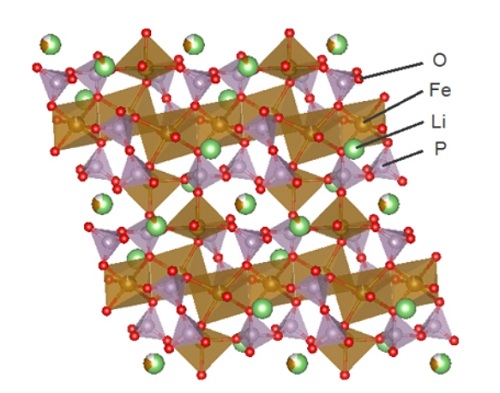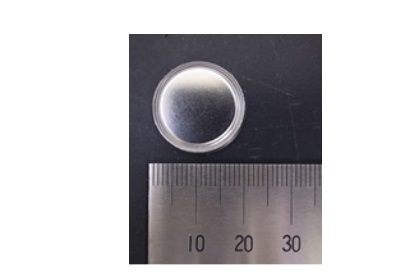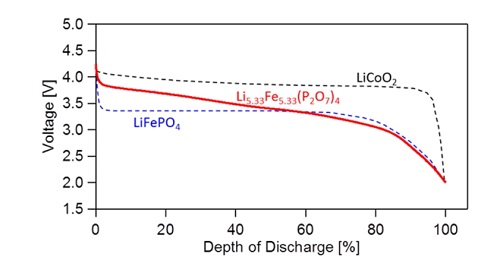|
Fujitsu Develops High-Voltage Cathode Material for Lithium Iron Phosphate Rechargeable Batteries
Enables production of low-cost, cobalt-free lithium rechargeable batteries
KAWASAKI, Japan, May 29, 2017 - (JCN Newswire) - Fujitsu Laboratories Ltd. today announced that it has successfully developed a cathode material for lithium iron phosphate rechargeable batteries. This new material offers high voltage that could only be achieved by cobalt-based materials in the past.
 | | Figure 1: Crystal structure of the new material |
 | | Figure 2: Prototype coin-shaped battery |
 | | Figure 3: Voltage and discharge depth(2) of the prototype coin battery |
Currently, the rare metal cobalt is a component of cathodes in high capacity and high-voltage lithium rechargeable batteries for electric vehicles (EVs) and home storage batteries. As these devices become more popular, there are concerns regarding future shortages of cobalt used in rechargeable lithium-ion batteries. Significant cost increases are also expected, generating interest in abundant and cheap iron to replace cobalt as the constituent element in rechargeable batteries. However, iron could not offer voltage comparable to that of cobalt-based materials.
Now Fujitsu Laboratories has discovered a new factor that can improve the voltage of iron-based materials. Using a proprietary materials design technology as well as a technology that precisely controls the composition of raw materials and the formation process of materials, Fujitsu Laboratories has successfully synthesized lithium iron pyrophosphate (Li5.33Fe5.33(P2O7)4). This phosphate-based material has a voltage of 3.8 V, comparable to that of existing cobalt-based materials.
In the future, Fujitsu Laboratories will seek to improve the performance of cathodes using this newly developed iron-based material. By advancing the design of new crystal structures that can maintain a high voltage state for longer periods, Fujitsu Laboratories aims to develop cathode materials that offer high energy density comparable to cobalt-based materials. In this way, Fujitsu Laboratories will contribute to lowering the cost of lithium rechargeable batteries and the devices that use them.
Details are being announced at the 231st ECS Meeting, an international conference on electrochemistry, currently underway in New Orleans, U.S., from May 28 to June 1.
Development Background
Currently, lithium-ion batteries are widely used as high-performance rechargeable batteries. However, there are concerns about insufficient supply and rising costs, as the batteries' cathode materials contain the rare metal cobalt, such as lithium cobalt oxide (LiCoO2). Large volumes of lithium-ion batteries will be required in the future for electric vehicles in order to achieve a low-carbon society that does not rely on fossil fuels and emit greenhouse gasses in the age of global warming. Consequently there has been a great deal of interest in developing materials that use iron, which is abundant on earth, as a constituent element in place of cobalt.
Issues
Previously, there was a problem with lithium-ion batteries using iron-based materials as they could not reach the energy density of those using cobalt-based materials. Energy density is expressed as a product of capacity density and voltage. Accordingly, iron-based materials with voltage of 2.8 V to 3.5 V could not compete with cobalt-based materials whose voltage ranged from 3.75 V to 4.1 V. It is known that the voltage of cathode materials can change depending on the arrangement of atoms in the crystal structure, which created issues in the development of new iron-based materials with high voltage.
About the Newly Developed Technology
Now, by analyzing the correlation between the crystal structure of iron-based materials and their electrochemical characteristics, Fujitsu Laboratories has discovered new factors in improving the voltage of iron-based materials. Using a proprietary materials design technology and a technology that precisely controls the composition of raw materials and the formation process of materials, the corporation has successfully synthesized lithium iron pyrophosphate (Li5.33Fe5.33(P2O7)4). This phosphate-based material has a voltage of 3.8 V, comparable to that of existing cobalt-based materials.
Details of the newly developed technology are as follows:
1. Discovered new factors improving the voltage of iron-based materials
The voltage of cathode materials is significantly influenced by the coordination of elements such as iron and oxygen in the crystal. By analyzing the interrelationship between the crystal structure of a material and its electrochemical characteristics, Fujitsu Laboratories discovered new factors in improving the voltage of iron-based cathode materials. In fact, it was discovered that a distorted arrangement of oxygen atoms around iron atoms is one of critical factors for the high voltage.
2. Successfully developed iron-based materials with high voltage comparable to cobalt-based materials
Using a proprietary Fujitsu Laboratories technology that precisely controls the coordination of raw materials and the formation of the material, Fujitsu Laboratories succeeded in synthesizing lithium iron pyrophosphate (Li5.33Fe5.33(P2O7)4), a new iron phosphate-based material (Figure 1). Fujitsu Laboratories created a coin-shaped prototype battery (Figure 2) and based on the results of its electrochemical properties evaluation, it was confirmed that it could achieve a voltage of 3.8 V, comparable to that of existing cobalt-based materials. This material has an even higher voltage than previously developed iron phosphate-based materials, represented by lithium iron phosphate (LiFePO4) (Figure 3).
The charge capacity of the prototype coin battery is about 105 mAh/g(1), which accounts for approximately 75% of the theoretical value of 139 mAh/g (Li5.33Fe5.33(P2O7)4), or the actual value of 137 mAh/g (LiCoO2). Through continued analysis, Fujitsu Laboratories plans to further improve such figures.
http://www.acnnewswire.com/topimg/Low_FujitsuCathodeMaterialFig1.JPG
Figure 1: Crystal structure of the new material
http://www.acnnewswire.com/topimg/Low_FujitsuCathodeMaterialFig2.JPG
Figure 2: Prototype coin-shaped battery
http://www.acnnewswire.com/topimg/Low_FujitsuCathodeMaterialFig3.JPG
Figure 3: Voltage and discharge depth (*2) of the prototype coin battery
Results
The newly-developed cathode material has not reached a voltage equal to existing cobalt-based materials in terms of energy density. Nonetheless, it has paved the way to increase the voltage of iron-based materials, resolving a roadblock in the research development.
In addition, cobalt-based cathode materials are used in lithium-ion batteries for electric vehicles as well as devices such as smartphones and digital cameras. If a cathode material is developed with the same energy density as cobalt-based materials, this will enable the stable production of cathode materials by replacing the rare metal cobalt with abundant iron. Moreover, this is expected to contribute to the stable production of lithium-ion batteries and the devices which use them, such as electric vehicles.
Future Plans
Based on this cathode development, Fujitsu Laboratories will work to design a crystal structure that can maintain a voltage on par with cobalt-based materials for longer periods. The electrode can also be used as a low-cost cathode material in safe, solid-state rechargeable batteries. Fujitsu Laboratories will contribute to a more sustainable and comfortable society by developing next-generation high-energy-density rechargeable batteries that are safer, cheaper and environmentally friendly.
(1) mAh/g
An expression of capacity density per one gram of cathode material, this is the electrical current required when it is assumed that it will take one hour for a battery to completely discharge from a fully charged state.
(2) Discharge depth
The percentage of a battery's capacity discharged from its fully charged state at 100%
About Fujitsu Laboratories
Founded in 1968 as a wholly owned subsidiary of Fujitsu Limited, Fujitsu Laboratories Ltd. is one of the premier research centers in the world. With a global network of laboratories in Japan, China, the United States and Europe, the organization conducts a wide range of basic and applied research in the areas of Next-generation Services, Computer Servers, Networks, Electronic Devices and Advanced Materials. For more information, please see: http://www.fujitsu.com/jp/group/labs/en/.
Contact:Fujitsu Laboratories Ltd.
Devices & Materials Laboratory
E-mail: battery@ml.labs.fujitsu.com
Fujitsu Limited
Public and Investor Relations
Tel: +81-3-3215-5259
URL: www.fujitsu.com/global/news/contacts/
Source: Fujitsu Ltd
Sectors: Electronics
Copyright ©2024 JCN Newswire. All rights reserved. A division of Japan Corporate News Network. |
Latest Release

First-ever Mazda CX-80 Crossover SUV Unveiled in Europe
Apr 19, 2024 13:50 JST
| 
Fujitsu develops technology to convert corporate digital identity credentials, enabling participation of non-European companies in European data spaces
Apr 19, 2024 10:17 JST
| 
Mitsubishi Heavy Industries and NGK to Jointly Develop Hydrogen Purification System from Ammonia Cracking Gas
Apr 18, 2024 17:01 JST
| 
Toyota Launches All-New Land Cruiser "250" Series in Japan
Apr 18, 2024 13:39 JST
| 
Fujitsu and Oracle collaborate to deliver sovereign cloud and AI capabilities in Japan
Apr 18, 2024 11:14 JST
| 
Eisai: Research on Treatments for Alzheimer's Disease Based on Its Pathological Mechanisms Recieves Award for Science and Technology (Research Category)
Apr 18, 2024 10:53 JST
| 
All-New Triton Confirmed as First Double-Cab Pickup Truck to Achieve 2024 Five-Star ANCAP Safety Rating
Apr 18, 2024 09:22 JST
| 
Eisai's Antiepileptic Drug Fycompa Injection Formulation Launched In Japan
Apr 17, 2024 16:17 JST
| 
Honda Unveils Next-generation EV Series for China
Apr 17, 2024 12:15 JST
| 
Lexus presents Time at the 2024 Milan Design Week
Apr 16, 2024 18:49 JST
| 
Mitsubishi Corporation Announces Participation in a DAC Project in Louisiana, USA
Apr 16, 2024 14:36 JST
| 
New circuit challenge for TOYOTA GAZOO Racing
Apr 15, 2024 17:21 JST
| 
TOYOTA GAZOO Racing back on asphalt for Croatian challenge
Apr 12, 2024 19:36 JST
| 
Heidelberg Materials North America Announces Latest Milestone in Edmonton CCUS Project
Apr 12, 2024 14:39 JST
| 
MHIAEL Completes Expansion of the its Nagasaki Plant for Manufacture of Aero Engine Combustors
Apr 11, 2024 18:08 JST
| 
Mitsubishi Shipbuilding Acquires Approval in Principle (AiP) from Classification Society ClassNK for Ammonia Fuel Supply System (AFSS)
Apr 11, 2024 17:50 JST
| 
DOCOMO, NTT, NEC and Fujitsu Develop Top-level Sub-terahertz 6G Device Capable of Ultra-high-speed 100 Gbps Transmission
Apr 11, 2024 15:10 JST
| 
Mitsubishi Corporation Announces Completion of Capital Raise by Nexamp
Apr 11, 2024 13:07 JST
| 
Mitsubishi Shipbuilding Receives Order for Ammonia Fuel Supply System for Ammonia-Powered Marine Engine
Apr 10, 2024 16:55 JST
| 
Transgene and NEC Present First Clinical Benefits of Neoantigen Cancer Vaccine, TG4050, in Head & Neck Cancer at AACR 2024
Apr 10, 2024 13:36 JST
|
More Latest Release >>
|